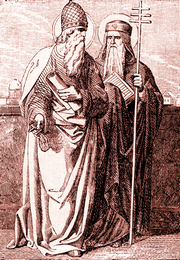Lives of the Saints
Our Models and Protectors
Spiritual Bouquet:
April 22

Saint Soter
and Saint Caius
Popes, Martyrs
(†175 and †296)
Saint Soter was raised to the papacy upon the death of Saint Anicetus in 161. By the sweetness of his discourses he comforted all afflicted persons with the tenderness of a father, and assisted the indigent with liberal alms, especially those who suffered for the Faith. He liberally extended his charities, according to the custom of his predecessors, to remote churches. He aided in particular that of Corinth, to which he addressed an excellent letter. Saint Dionysius of Corinth in his letter of thanks to Saint Soter, adds that the Pontifical letter together with the letter of Saint Clement, Pope, was read for the edification of the faithful on Sundays, during their assemblies to celebrate the divine mysteries.
One of Saint Soter's ordinances required all Christians except those in public penance to receive Communion on Holy Thursday. Saint Soter vigorously opposed the heresy of Montanus, and governed the Church up to the year 175. He was martyred on April 22, 175, under the emperor Marcus Aurelius, and buried on the Appian Way in the cemetery of Callixtus.
Pope Saint Caius, born in Dalmatia, was a relative of the emperor Diocletian. The cruel emperor did not for that reason spare him or his family during the bloody persecution of the years 283 to 296, during which the Christians of Rome were obliged to conceal themselves in caverns and cemeteries.
Saint Caius counseled a patrician named Chromatius to receive the tracked disciples of Christ in his country residence. He himself went to visit them on a Sunday, and said to the faithful assembled there that Our Lord Jesus Christ, knowing the fragility of human nature, established two degrees in the practice of Christianity, confession and martyrdom. Our Saviour did so, he said, so that those who do not believe they could stand up under torment, may nonetheless conserve the grace of the faith by their confession. Our Lord had indeed specified, When you are persecuted in one city, flee to another... Then he said, Those who wish to stay in the house of Chromatius, remain with Tiburtius, while those who prefer to return with me to the city, come. Several followed him back to Rome; among them are the martyrs of the same persecution, the brothers Saints Marcus and Marcellinus, and Saint Sebastian.
Saint Caius himself received the crown of martyrdom in the final year of the persecution, 296, and was buried in the cemetery of Callixtus, where his body was found in 1622, with an inscription identifying him as Vicar of Christ.
Little Pictorial Lives of the Saints, a compilation based on Butler's Lives of the Saints and other sources by John Gilmary Shea (Benziger Brothers: New York, 1894); Les Petits Bollandistes: Vies des Saints, by Msgr. Paul Guérin (Bloud et Barral: Paris, 1882), Vol. 4